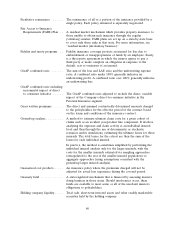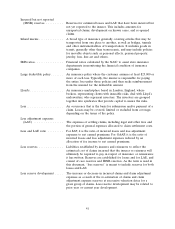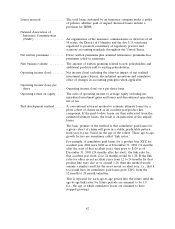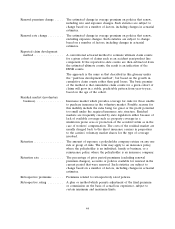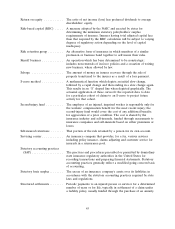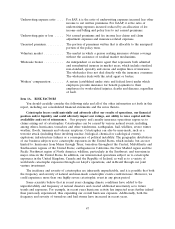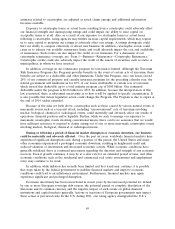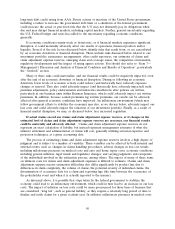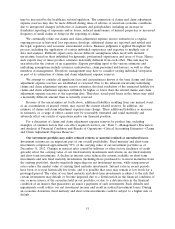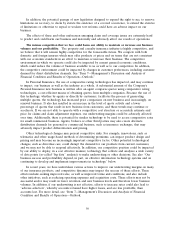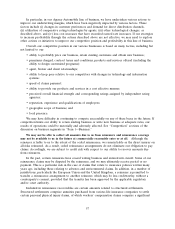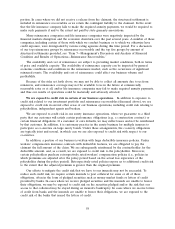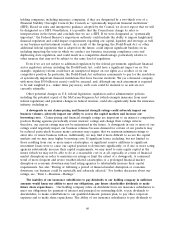Travelers 2012 Annual Report Download - page 62
Download and view the complete annual report
Please find page 62 of the 2012 Travelers annual report below. You can navigate through the pages in the report by either clicking on the pages listed below, or by using the keyword search tool below to find specific information within the annual report.long-term debt credit rating from AAA. Future actions or inactions of the United States government,
including a failure to increase the government debt limit or a shutdown of the federal government,
could increase the actual or perceived risk that the U.S. may not ultimately pay its obligations when
due and may disrupt financial markets, including capital markets. Further, general uncertainty regarding
the U.S. Federal budget and taxes has added to the uncertainty regarding economic conditions
generally.
If economic conditions remain weak or deteriorate, or if financial markets experience significant
disruption, it could materially adversely affect our results of operations, financial position and/or
liquidity. Several of the risk factors discussed below identify risks that result from, or are exacerbated
by, an economic slowdown or financial disruption. These include risks discussed below related to our
investment portfolio, reinsurance arrangements, other credit exposures, our estimates of claims and
claim adjustment expense reserves, emerging claim and coverage issues, the competitive environment,
regulatory developments and the impact of rating agency actions. You should also refer to ‘‘Item 7—
Management’s Discussion and Analysis of Financial Condition and Results of Operation’’, particularly
the ‘‘Outlook’’ section.
Many of these risks could materialize, and our financial results could be negatively impacted, even
after the end of an economic downturn or financial disruption. During or following an economic
downturn, lower levels of economic activity could reduce (and historically have reduced) exposure
changes at renewal. They also could adversely impact (and historically have adversely impacted) audit
premium adjustments, policy endorsements and mid-term cancellations after policies are written,
particularly in our business units within Business Insurance, which could adversely impact our written
premiums. In addition, because earned premiums lag written premiums, our results can be adversely
affected after general economic conditions have improved. An inflationary environment (which may
follow government efforts to stabilize the economy) may also, as we discuss below, adversely impact our
loss costs and could adversely impact the valuation of our investment portfolio. Finally, as a result of
financial market disruption, we may, as discussed below, face increased regulation.
If actual claims exceed our claims and claim adjustment expense reserves, or if changes in the
estimated level of claims and claim adjustment expense reserves are necessary, our financial results
could be materially and adversely affected. Claims and claim adjustment expense reserves do not
represent an exact calculation of liability, but instead represent management estimates of what the
ultimate settlement and administration of claims will cost, generally utilizing actuarial expertise and
projection techniques, at a given accounting date.
The process of estimating claims and claim adjustment expense reserves involves a high degree of
judgment and is subject to a number of variables. These variables can be affected by both internal and
external events, such as: changes in claims handling procedures; adverse changes in loss cost trends,
including inflationary pressures on medical costs and auto and home repair costs; economic conditions
including general inflation; legal trends and legislative changes; and varying judgments and viewpoints
of the individuals involved in the estimation process, among others. The impact of many of these items
on ultimate costs for claims and claim adjustment expenses is difficult to estimate. Claims and claim
adjustment expense reserve estimation difficulties also differ significantly by product line due to
differences in claim complexity, the volume of claims, the potential severity of individual claims, the
determination of occurrence date for a claim and reporting lags (the time between the occurrence of
the policyholder event and when it is actually reported to the insurer).
As discussed above, it is possible that steps taken by the federal government to stabilize the
economy could lead to an inflationary environment, which could in turn lead to an increase in our loss
costs. The impact of inflation on loss costs could be more pronounced for those lines of business that
are considered ‘‘long tail’’, such as general liability, as they require a relatively long period of time to
finalize and settle claims for a given accident year. In addition, inflationary pressures in medical costs
50


